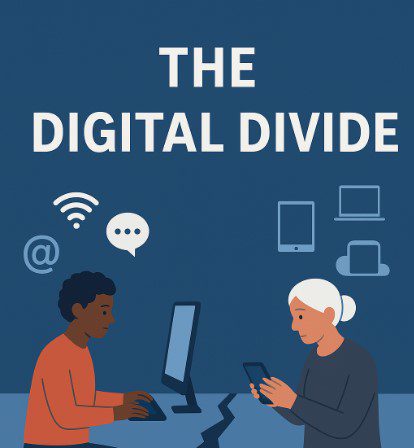The digital divide is a growing global concern that refers to the unequal access to and use of information and communication technologies (ICTs), such as computers, smartphones, and the internet. This divide exists not only between developed and developing countries but also within countries, along urban-rural lines, age groups, gender, income brackets, and educational levels.
Rather than a singular gap, the digital divide is multidimensional, reflecting disparities in access, quality, affordability, digital literacy, and meaningful engagement with digital tools. As societies increasingly rely on ICTs for education, employment, healthcare, and governance, the digital divide becomes both a symptom and a cause of broader social inequality.
2. Types of Digital Divide
A. Access Divide
Definition: The access divide reflects the fundamental gap between those who have physical access to ICT infrastructure (devices and internet connections) and those who do not.
Key Factors:
-
Internet Connectivity: Broadband, fiber optics, and mobile internet penetration vary by region.
-
Affordability: Cost of devices, data packages, and service plans.
-
Device Availability: Access to quality digital hardware such as laptops, smartphones, or tablets.
Impacted Groups:
-
Rural Populations: Often underserved due to high infrastructure costs.
-
Low-Income Households: Unable to afford equipment or subscriptions.
-
Elderly Individuals: Less likely to invest in or feel comfortable using ICTs.
B. Usage Divide
Definition: The usage divide refers to differences in the quality and purpose of internet use, even when basic access is available.
Key Factors:
-
Digital Literacy: Ability to understand, evaluate, and use digital information effectively.
-
Skill Application: Differences between using the internet for entertainment vs. productivity, education, or financial transactions.
-
Confidence and Motivation: Technological anxiety or resistance to change.
Consequences:
-
Unequal Benefit: Some individuals only use technology passively, missing out on economic or educational advantages.
-
Limited Empowerment: Lack of usage skills reduces competitiveness in job markets or digital entrepreneurship.
C. Socioeconomic Divide
Definition: This divide reflects how variables such as income, education, age, gender, and occupation affect digital engagement.
Key Observations:
-
Income and Education: Wealthier and more educated individuals generally have better access and more advanced digital skills.
-
Age Divide: Older adults may face physical and cognitive barriers to ICT adoption.
-
Gender Gap: Cultural, social, and economic factors often restrict women’s digital inclusion in developing countries.
Example: According to the ITU (International Telecommunication Union), as of 2023, internet use among women in low-income countries was 12% lower than among men.
D. Geographic Divide
Definition: This divide highlights how location determines digital opportunities and constraints.
Key Issues:
-
Urban vs. Rural Divide: Urban areas have more developed ICT infrastructure and services.
-
Underserved Areas: Lack of commercial incentives to invest in sparsely populated regions.
-
Developing vs. Developed Countries: Technological penetration and digital literacy remain significantly lower in many developing nations.
Examples:
-
In the United States, about 24 million people—mostly in rural areas—lack access to reliable broadband (FCC, 2022).
-
In Sub-Saharan Africa, less than 30% of the population had regular access to the internet in 2023.
3. Causes of Digital Disparity
-
Infrastructure Gaps:
-
Insufficient investment in broadband and mobile networks.
-
High cost of laying fiber-optic cables in remote or rugged terrain.
-
-
Economic Barriers:
-
High cost of digital devices and monthly subscriptions.
-
Digital tools seen as luxury items rather than necessities.
-
-
Educational Inequality:
-
Poor access to digital literacy training in underprivileged schools or communities.
-
Language barriers and low general literacy rates.
-
-
Policy and Governance Challenges:
-
Absence of inclusive national ICT strategies.
-
Weak regulatory frameworks that fail to encourage competition and affordability.
-
-
Cultural and Social Factors:
-
Patriarchal norms limiting women’s internet use.
-
Content not available in local languages or formats suitable for users with low literacy.
-
4. Impacts of the Digital Divide
A. Economic Impacts:
-
Reduced access to online job markets, freelancing, and remote work.
-
Barriers to small business participation in the digital economy.
B. Educational Impacts:
-
Students in digitally excluded homes fall behind in e-learning or hybrid education models.
-
Schools without internet cannot adopt modern teaching aids or global resources.
C. Healthcare Impacts:
-
Limited access to telehealth and online medical consultations, especially during crises like COVID-19.
-
Inadequate dissemination of public health information through digital means.
D. Civic and Social Participation:
-
Exclusion from e-governance services such as online voting, public complaint systems, and digital identification.
-
Limited engagement in digital activism, online community forums, or democratic dialogue.
5. Addressing the Digital Divide
A. Policy and Infrastructure Development
-
National broadband plans with clear goals for rural and marginalized areas.
-
Public-private partnerships to extend affordable internet services.
-
Encouraging competition among ISPs to reduce prices.
B. Education and Digital Training
-
Incorporating ICT in school curricula from early grades.
-
Community centres offering free or subsidised digital literacy programs.
-
Empowering teachers and facilitators with tech-based teaching methods.
C. Economic and Social Support
-
Providing low-cost digital devices or subsidies to low-income groups.
-
Developing public access infrastructure: libraries, schools, and community centres equipped with ICT tools.
D. Inclusive Digital Design
-
Promoting content in local languages and regional dialects.
-
Accessibility features for persons with disabilities (screen readers, subtitles, simple interfaces).
-
User-centred design focusing on intuitive interfaces for first-time users.
Conclusion
The digital divide is more than a technological issue—it is a social justice concern that reflects and reinforces existing inequalities. Addressing it requires a multifaceted strategy that combines infrastructure development, education, affordability, inclusive policies, and cultural sensitivity. In a digitalized world, closing the digital divide is essential not only for individual empowerment but also for national progress, innovation, and equitable development.
Stay tuned with Socityopedia.com for more!

